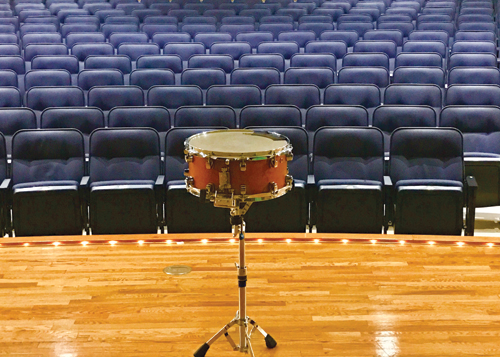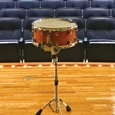Over more than 20 years of teaching I have worked both as an educator and as an adjudicator with countless students auditioning for honor groups or participating in solo and ensemble festivals. I have noticed a few common errors that, if addressed prior to the performance, could help students score better and therefore place higher.

Entering the Room
Students should have their materials organized prior to entering the room. The better the plan for implements (sticks, mallets, or beaters) and small percussion instruments, the less stressed students will be during the performance. They should take only the materials needed into the room with them. Have them practice entering the room and setting up the performance area. This process should take less than one minute and can help set the stage for a successful performance.
Upon entering the room, students should immediately begin setting up the performance area, placing implements on a flattened music stand covered by a small hand towel to prevent them from falling. Knowing where to place implements or small instruments ahead of time is only part of the strategy; students should always keep them in the same place. Stands and instruments should be moved to the configuration the student is accustomed to from practice sessions. It is especially important that students take time to adjust the instrument and music stands to optimal height. If a student will be playing a house snare drum, he should ask the room monitor if he can play a few notes to get used to the drum. Do not play portions of the excerpt or solo; save that for the performance.
Musicality Matters
Because a snare drum does not have the multitude of pitch possibilities that other instruments do, opportunities to stand out from the other performers must be created, and one of the best ways to do this is through dynamic contrast. It is impossible to have a high-scoring performance if dynamics are disregarded; this includes crescendos and decrescendos. Students should record themselves playing the material and pay attention to the dynamic levels and contrasts to get an idea of how the etude will sound to adjudicators. A snare drum can be an incredibly musical instrument when played properly, but it can sound like a machine gun when played unmusically.
Embellishments Are Important
Just like the variety of articulations on a wind instrument, embellishments on a snare drum cannot be ignored. Accents, grace notes, or slashes on the note stem all have very specific performance instructions. Ignoring these instructions fundamentally alters the music. These embellishments are not optional and will help to separate the drummers from the musicians in the audition. The difference between the measures in the passage below is extreme, both in how it feels to the players hands as well as how it sounds to the audience. The only compositional difference is the placement of the accent on each count of sixteenth notes.
.jpg)
Two grace notes are performed differently than three grace notes. Typically, in concert percussion music, it is appropriate to play the quarter notes below with two-note grace notes as a multiple bounce stroke or buzz, whereas the three-note grace notes are to be played as single-strokes. Often, students perform each of these ornaments the exact same but they are written to be performed differently.
.jpg)
Hidden Pitfalls or Traps
As students learn the music they should look for traps, which are extreme changes in dynamics or tempo. In the example below, the last count in the second measure should be noticeably stronger than the rest of the excerpt. A common mistake is to play the last count only slightly stronger than the previous passage when the sforzando accented quarter note calls for a drastic dynamic change.
.jpg)
Sometimes new dynamic markings or meter changes are placed at the beginning or end of a line of music and therefore can slide past without being given the performer’s full attention. All dynamic changes and phrasing instructions should be played with their full weight and consideration, regardless of where they are in the excerpt.
Use Appropriate Implements
Students should be sure to use the appropriate implements for the instrument at hand. Avoid yarn or cord mallets of the excerpt calls for xylophone. Avoid hard rubber or plastic mallets if the excerpt calls for marimba. Marching sticks are never appropriate for a concert snare performance and will cause the overall volume to be too loud. Soft yarn marimba mallets will work much better for a suspended cymbal excerpt than timpani mallets. Be sure to use a concert bass drum mallet rather than a marching mallet for concert bass drum excerpts.
Be Consistent
Consistency is key to any successful performance and includes such components as dynamic levels, rate of crescendos and decrescendos, tempi, and playing spots on the various instruments. When listening to recordings of themselves playing, students should check whether a return to a softer volume from a loud volume, is the same volume as when they previously played softly. The same holds true for loud volumes.
Sightreading Tips
If sightreading is required, students should look at both the beginning and the ending. Often performers spend all the allotted preparation time focusing on the beginning and fail to check the ending. Dynamics and dynamic contrast are especially important in sightreading; students are guaranteed to score higher if they perform musically, even if they miss a few pitches or rhythms when sightreading.
The sightreading tempo should be what allows the student to perform the most technically challenging passage at the highest level. Often, sightreading excerpts start relatively easy and increase in difficulty as they progress; students must resist the temptation to start too fast based on the appearance of simpler rhythms at the beginning of the sightreading excerpt. One suggestion would be to find the shortest note value in the excerpt and select a tempo at which the percussionist can accurately play that passage. Use this method makes it unlikely that the student will have to adjust tempo while playing.
Audition etudes often contain multiple-instrument parts with multi-measure rests between each. Students playing such an etude should pay strict attention to counting the appropriate number of measures between each instrument passage as they change instruments. A common mistake is to treat each instrument like separate excerpts and not commit to counting the correct number of rest measures.
Equipment Concerns
If the performance calls for instruments other than snare drum or a mallet percussion instrument, it is always wise for students to bring their instruments if possible. They have been rehearsing with those specific instruments in preparation for the performance and will be more familiar with them. There are a wide variety of professional-level triangles, triangle clips, triangle beaters, tambourines, concert bass drum mallets, etc. available, and each can provide a different feel or sound. To allow the performance to be as consistent as possible, the same small instruments or mallets should be used each time.
Only Play What’s on the Page
The adjudicators listening to the performance only want to hear the music contained in the actual etude. Students should not audibly count rests or loudly tap feet during rests. The shoes a student wears can affect the performance. Hard-soled shoes will make foot-tapping easy to hear during rests and will add extra sounds to the performance.
This also applies to transitions between small hand-held instruments like triangle and tambourine. There should be no additional sounds are made as an instrument is picked up or set down. A small hand towel on a flattened music stand will muffle the transition between these instruments.
Leaving the Performance Room
Once your performance is complete, students should quickly gather up their belongings and thank the room monitor as the exit. It is worth taking the time to practice the exit as students did entering the room. Every aspect of the performance should be as professional as possible; this includes entering, setting up, and exiting the room. Percussionists who focus on these details separate themselves from those who do not. A musical performance is all about the details.
Auditions and solo performances are intense and stressful activities. If students take time to prepare for logistics of the performance prior to the actual event, they can dramatically lower your stress levels on the big day. Students are far more likely to have a successful performance if they can manage stress to allow them to perform at their best.






